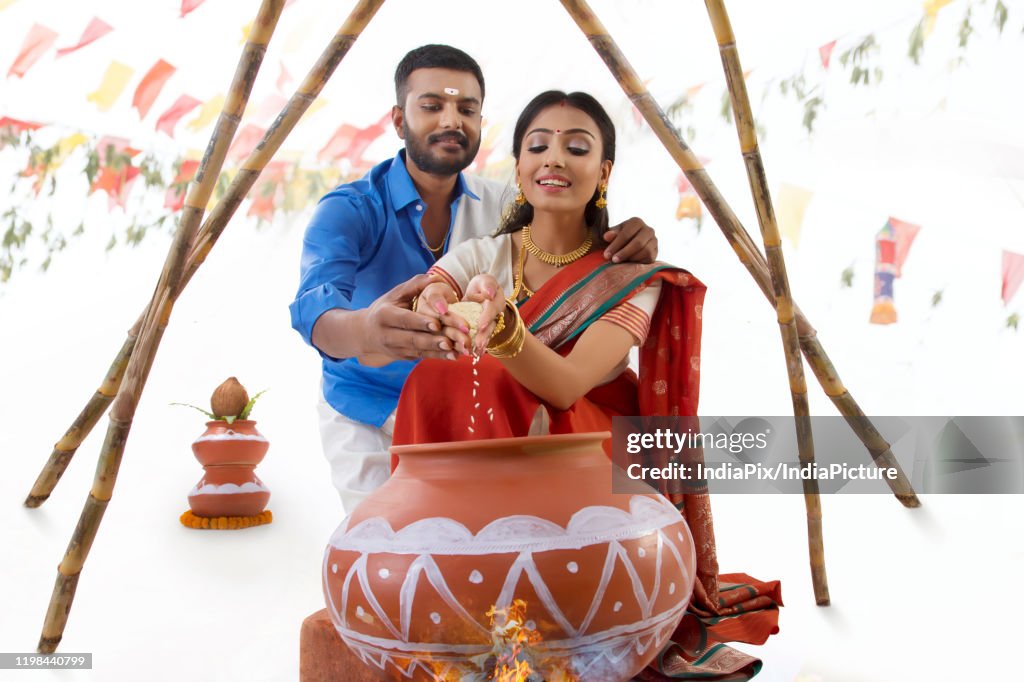My shopping cart
Your cart is currently empty.
Continue Shopping
Image Courtesy: https://www.gettyimages.com
We have awaited the New Year in style. Now comes the next major celebration that is coming up on your calendar. Well, you have guessed it right. It is the Sankranthi festival that I am talking about. Also known as ‘Pongal’ downsouth of India. Come on, let us see the meaning or significance of ‘Pongal or Sankranthi’ on a more detailed note.
You can call it ‘Pongal’ or ‘Sankranthi’. This is the farmer’s festival that is implied here. We pay our reverence to the Sun and Rain Gods who have been bountiful in providing rains or sunlight to help food crops grow aplenty. ‘Pongal’ is also known as the harvesting festival, as a matter of fact. Farmers grow food crops like paddy, wheat, maize, jowar , bajra, millets, corn, fruits and vegetables. This is how the food comes to your table.
We celebrate the harvesting fest as ‘Pongal’ in TamilNadu, Kerala, and Pondicherry. The fest is named ‘Sankranthi’ across households covering Andhra Pradesh, Telangana, and Karnataka. People call it ‘Baisakhi’ across parts of WestBengal, Odisha and parts of North-Eastern India. Households call the harvesting fest ‘Lohri’ in parts of Maharashtra, Gujarat, Uttar Pradesh, Madhya Pradesh, and Rajasthan. Hence in a way, the whole of India thank the gods to pour their benevolence in helping food crops grow.
If you look at it, in parts of South India, we have a three day festival connected with ‘Pongal’ Celebrations.
Day 1: People wear new clothes and adorn their homes with colorful rangolis. Women mainly make a platter using ‘rice’ as the staple ingredient. They make sweet pongal, salty pongal, chana dal vadas, rasam, sambhar, papads and lay out an entire South Indian platter out there. At households, they draw faces of the ‘Sun God’ and Moon God. Sugarcane is placed at either side of the spectrum. The significance here is, we are paying our homage and respects to the Sun and moon gods for taking care of the crops grown by farmers day and night.
Day 2: This is the day we dedicated to the ‘Oxen’ that plough the farmer’s land. Traditionally, farmers used ‘Ox’ to plough large tracts of agricultural lands. Today, tractors do the job for us. Hence cows, and oxen are decorated. In South India, this day is called ‘Mattu Pongal’ meaning a day dedicated to worshiping cows and oxen.
Day 3- The farming communities plan excursions or trips to their villages or towns. Plenty of food items are prepared. The farmer also known as ‘Uzhavar’ is named ‘Uzhavar Thirunaal’.
Typically, Sankranti is also celebrated with fervor and enthusiasm across parts of Andhra Pradesh, Telangana, and Karnataka. People wear new clothes and make sweets and savories gracing the occasion. At outlets in Bangalore, we get a delicacy called ‘Yellu Bellu’. This is sesame or til seeds mixed with jaggery bits, coconut pieces and colored confetti.
Typically, Lohri and Baisakhi are also celebrated across parts of India with greater enthusiasm. People make sweet bites and call guests home for lunches or a lavish platter of dinners. The pilgrim spots are also usually crowded during this time of the year. Devotees or pilgrimage enthusiasts go to Vrindavan or Mathura to seek the blessings of Lord Krishna.
In tomorrow’s segment, let us have a look at how traditional Sankranti recipes can be veganized. So stay tuned!
We are an online vegan store based out of India. We have personalized lifestyle products catering to people belonging to the present millennium. You get nut butters, mock meats, plant-based sweets, dairy-free alternatives, groceries and wellness care products from our store. Do check out some of our outstanding collections right here:
For more, log in to https://www.vvegano.com